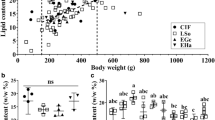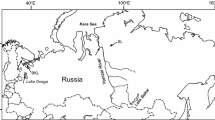Abstract
The main purpose of this study was to evaluate the gills and gonads of Vimba vimba in terms of fatty acid composition, esterase activity, and esterase band patterns by native-PAGE method. In this context, C16:0 and C18:1n-9 were the most abundant fatty acids in the TLs, NLs, and the PLs fractions of both tissues. EPA (C20:5n-3) and DHA (C22:6n-3) levels were higher in the gills than in the gonads. MUFAs were the main fatty acid groups in the TLs, NLs, and PLs of both tissues. Gills had higher n-3/n-6 ratios when compared with the gonads, with the exception of the PLs. TLs of the gonads had the highest AI and TI values. A concentration of 1 mM Na-taurocholate increased the esterase activity of the gonads. Other chemicals having inhibition and surface active effects resulted in decreases in the esterase activities at concentrations of 1, 5, and 10 mM. In total, nine esterase bands were determined in both tissues. Four bands were shared by both the gills and gonads of V.vimba. These shared bands could be responsible for the similar esterase activities in both tissues. Gills and gonads of V. vimba have substantial amounts of fatty acids and esterase isozymes. More detailed studies are required to understand their industrial and nutritional uses.

Similar content being viewed by others
Abbreviations
- AI:
-
Atherogenic Index
- ARA:
-
Arachidonic acid
- DHA:
-
Docosahexaenoic acid
- EPA:
-
Eicosapentaenoic acid
- FAME:
-
Fatty acid methyl ester
- MUFA:
-
Monounsaturated fatty acid
- n-3 PUFA:
-
Omega 3 polyunsaturated fatty acid
- NLs:
-
Neutral lipids
- PAGE:
-
Polyacrylamide gel electrophoresis
- SFA:
-
Saturated fatty acid
- PLs:
-
Polar lipids
- TI:
-
Thrombogenicity Index
- TLs:
-
Total lipids
References
Sargent J, Bell G, McEvoy L, Tocher D, Estevez A (1999) Recent developments in the essential fatty acid nutrition of fish. Aquaculture 177:191–199
Memon NN, Talpur FN, Bhanger MI, Balouch A (2011) Changes in fatty acid composition in muscle of three farmed carp fish species (Labeo rohita, Cirrhinus mrigala, Catla catla) raised under the same conditions. Food Chem 126:405–410
Lauritzen L, Hansen HS, Jorgensen MH, Michaelsen KF (2001) The essentiality of long chain n-3 fatty acids in relation to development and function of the brain and retina. Prog Lipid Res 40:1–94
Navarro-Garcia G, Gonzalez-Felix ML, Marquez-Farias F, Bringas-Alvarado L, Perez-Velazquez M, Montoya-Laos JM, Moreno-Silva B (2014) Lipid content and fatty acid composition of the liver from the rajiforms Urotrygon chilensis, Urobatis halleri, Rhinobatos glaucostigma, Rhinoptera steindachneri and Dasyatis dipeteura captured in Sinaloa, Mexico. Int Food Res J 21(1):229–235
Cakmak YS, Zengin G, Guler GO, Aktumsek A, Ozparlak H (2012) Fatty acid composition and Ω3/Ω6 ratios of the muscle lipids of six fish species in Sugla Lake, Turkey. Arch Biol Sci Belgrade 64(2):471–477
Uysal K, Bülbül M, Dönmez M, Seçkin AK (2008) Changes in some components of the muscle lipids of three freshwater fish species under natural extreme cold and temperate conditions. Fish Physiol Biochem 34:455–463
Görgün S, Akpınar N, Dirican S (2014) A comparative study on the fatty acid profiles of total lipid, neutral and polar lipids in the liver and muscle of Capoeta sieboldii (Steindachner, 1864) and Capoeta baliki (Turan, Kottelat, Ekmekçi, İmamoğlu, 2006) from Tödürge Lake (Sivas, Turkey). Acta Alim 43(1):170–181
Tocher DR, Bendiksen EA, Campbell PJ, Bell JG (2008) The role of phospholipids in nutrition and metabolism of teleost fish. Aquaculture 280:21–34
Gonçalves LU, Parisi G, Bonelli A, Sussel FR, Viegas EMM (2014) The fatty acid composition of total, neutral and polar lipids in wild and farmed lambari (Atyanax altiparanae) (Garutti & Britski, 2000) broodstock. Aquacult Res 45:195–203
Beisson F, Tiss A, Riviere C, Verger R (2000) Methods for lipase detection and assay: a critical review. Eur J Lipid Sci Technol 102(2):133–153. doi:10.1002/(SICI)1438-9312(200002)102:2<133::AID-EJLT133>3.0.CO;2-X
Gilham D, Lehner R (2005) Techniques to measure lipase and esterase activity in vitro. Methods 36:139–147
Fahmy AS, Abo-Zeid AZ, Mohamed TM, Ghanem HM, Borai IH, Mohamed SA (2008) Characterization of esterases from Cucurbita pepo cv. “Eskandrani”. Bioresour Technol 99:437–443
Bollag DM, Rozycki MD, Edelstein SJ (1996) Protein methods. Wiley, New York, pp 57–82
Aravindan R, Anbumathi P, Viruthagiri T (2007) Lipase application in food industry. Indian J Biotechnol 6:141–158
Okgerman HC, Yardımcı CH, Dorak Z, Yılmaz N (2013) Feeding ecology of vimba (Vimba vimba L., 1758) in terms of size groups and seasons in Lake Sapanca, northwestern Anatolia. Turk J Zool 37:288–297
Kalyoncu L, Kıssal S, Aktumsek A (2009) Seasonal changes in the total fatty acid composition of vimba, Vimba vimba tenella (Nordmann, 1840) in Eğirdir Lake, Turkey. Food Chem 116:728–730
Görgün S, Akpınar N, Zengin G, Akpınar MA, Günlü A, Güler GO, Aktümsek A (2013) Determination of fatty acid profiles of total, neutral, and polar lipids in different tissues of Vimba vimba (L., 1758) from Eğirdir Lake (Isparta, Turkey). Turk J Zool 37:627–634
Folch J, Less M, Sloane Stanley GH (1957) A simple method for the isolation and purification of total lipids from animal tissues. J Biol Chem 226:497–509
Kozlova TA, Khotimchenko SV (2000) Lipids and fatty acids of two pelagic cottoid fishes (Comephorus spp) endemic to Lake Baikal. Comp Biochem Phys B 126:477–485
Moss CW, Lambert MA, Mervin WH (1974) Comparison of rapid methods for analysis of bacterial fatty acids. Appl Microbiol 28:80–85
Ulbricht TLV, Southgate DAT (1991) Coronary heart disease: seven dietary factors. Lancet 338:985–992
Ülker S, Özel A, Çolak A, Alpay Karaoğlu Ş (2011) Isolation, production, and characterization of an extracellular lipase from Trichoderma harzianum isolated from soil. Turk J Biol 35:543–550
Akpınar MA, Görgün S, Akpınar AE (2009) A comparative analysis of the fatty acid profiles in the liver and muscles of male and female Salmo trutta macrostigma. Food Chem 112:6–8
Jankowska B, Zakes Z, Zmijewski T, Szczepkowski M (2010) Fatty acid profile of muscles, liver and mesenteric fat in wild and reared perch (Perca fluviatilis L.). Food Chem 118:764–768
Valfre F, Caprino F, Turchini GM (2003) The health benefit of seafood. Vet Res Commun 27:507–512
Grigorakis K, Fountoulaki E, Vasilaki A, Mittakos I, Nathanailides C (2011) Lipid quality and filleting yield of reared meagre (Argyrosomus regius). Int J Food Sci Tech 46:711–716
Görgün S, Akpınar MA (2012) Purification and characterization of lipase from the liver of carp, Cyprinus carpio L. (1758), living in Lake Tödürge (Sivas, Türkiye). Turk J Fish Aquat Sc 12:207–215
Kurtovic I, Marshall SN, Zhao X, Simpson BK (2010) Purification and properties of digestive lipases from Chinook salmon (Oncorhynchus tshawytscha) and New Zealand hoki (Macruronus novaezelandiae). Fish Physiol Biochem 36(4):1041–1060
Lima VMG, Krieger N, Mitchell DA, Fontana JD (2004) Activity and stability of a crude lipase from Penicillium aurantiogriseum in aqueous media and organic solvents. Biochem Eng J 18(1):65–71
Leticia A-G, Gerardo G-B (2008) Determination of esterase activity and characterization of cholinesterases in the reef fish Haemulon plumieri. Ecotox Environ Safe 71:787–797
Shahjanan RM, Karim A, Begum RA, Alam MS, Begum A (2008) Tissue specific esterase isozyme banding pattern in the Nile Tilapia (Oreochromis niloticus). Univ J Zool Rajshahi Univ 27:1–5
Begum RA, Rahman DT, Rashid MA, Alam MS, Shahjanan RM (2012) Comparison of esterase isozyme variability in some selected tissues of the Asian and African catfishes (Siluriformes: Clariidae). Bangladesh J Zool 40(1):43–50
Acknowledgments
We thank Dr. Ali Günlü (Muğla Sıtkı Koçman University) for providing the fish samples. We also thank Michelle J Towers (Cumhuriyet University) for the English edition of the manuscript.
Author information
Authors and Affiliations
Corresponding author
About this article
Cite this article
Görgün, S., Zengin, G. Determination of Fatty Acid Profiles and Esterase Activities in the Gills and Gonads of Vimba vimba (L., 1758). J Am Oil Chem Soc 92, 353–360 (2015). https://doi.org/10.1007/s11746-015-2602-y
Received:
Revised:
Accepted:
Published:
Issue Date:
DOI: https://doi.org/10.1007/s11746-015-2602-y




